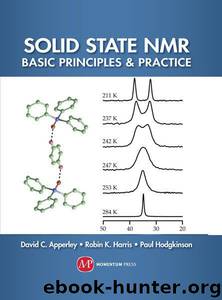Solid-State NMR: Basic Principles and Practice by Apperley David C. & Harris Robin K. & Hodgkinson Paul

Author:Apperley, David C. & Harris, Robin K. & Hodgkinson, Paul [Apperley, David C.]
Language: eng
Format: epub
Publisher: Momentum Press
Published: 2012-06-09T16:00:00+00:00
5.5 HOMONUCLEAR DECOUPLING
The suppression of the strong dipolar couplings between protons in the solid state has been a repeated theme in many of the experiments described above. This section explores this important topic in greater detail.
As discussed in section 2.7 and inset 4.5, the Hamiltonian for a collection of spins coupled by homonuclear dipolar couplings behaves “homogeneously” under MAS; in contrast to other anisotropic interactions such as the CSA, MAS does not break up the static lineshape into a set of sharp spinning sidebands, but rather the sidebands (and centerband) have a finite width that decreases only modestly with increasing spin rate. (To a good first approximation, the linewidths decrease inversely with increasing spin rate.)
The problem of limited resolution is particularly acute in 1 H NMR. This is firstly due to the strength of the homonuclear interactions; 1 H has a high magnetogyric ratio and individual dipolar couplings are large (e.g., over 20 kHz for the two protons in a rigid CH2 group), resulting in a large overall homogeneous linewidth (typically ~50 kHz for a rigid solid). Secondly, the 1 H chemical shift range is limited to about 15 ppm, which corresponds to a range of frequencies of only 7.5 kHz at an 1 H Larmor frequency of 500 MHz. As a result, even the fastest MAS is typically only able to resolve a handful of distinct resonances. The situation is much easier for other abundant spins such as 19 F and 31 P since overall coupling strengths are lower and the range of NMR frequencies spanned is much larger, particularly at higher magnetic fields. It is usually much easier when working at current magnetic field strengths14 to use fast MAS rather than homonuclear decoupling for these nuclei. The remainder of this section focuses exclusively on homonuclear decoupling applied to 1 H.
Achieving useful resolution in a 1 H spectrum requires the effects of the homonuclear couplings to be suppressed by more than two orders of magnitude. This is a demanding requirement, and even small experimental imperfections can become noticeable when such high levels of performance are needed. Moreover, homonuclear decoupling is subject to a variety of experimental factors that are often hard to control or characterize (e.g., variation of B 1 across the sample, finite rise and fall time of pulses). The higher the resolution expected from the homonuclear decoupling, the more critical the experimental set-up.
A significant complication associated with all the widely used decoupling sequences (see below) is that the 1 H magnetization precesses about a tilted axis during the homonuclear decoupling, rather than precessing about the z axis as is the case in the absence of RF irradiation (Figure 5.16 ). Moreover, the exact position of the precession axis is not always well defined, as a result of experimental imperfections. Sampling the raw x and y magnetization leads to quadrature errors when the signal is Fourier transformed, that is, artifact peaks appear at frequency –f for each genuine signal at frequency f . The usual solution is to
Download
This site does not store any files on its server. We only index and link to content provided by other sites. Please contact the content providers to delete copyright contents if any and email us, we'll remove relevant links or contents immediately.
The Complete Stick Figure Physics Tutorials by Allen Sarah(6631)
Secrets of Antigravity Propulsion: Tesla, UFOs, and Classified Aerospace Technology by Ph.D. Paul A. Laviolette(3430)
Thing Explainer by Randall Munroe(3318)
The River of Consciousness by Oliver Sacks(2988)
The Order of Time by Carlo Rovelli(2708)
I Live in the Future & Here's How It Works by Nick Bilton(2520)
A Brief History of Time by Stephen Hawking(2470)
How To by Randall Munroe(2465)
The Great Unknown by Marcus du Sautoy(2179)
What If?: Serious Scientific Answers to Absurd Hypothetical Questions by Randall Munroe(2166)
Blockchain: Ultimate Step By Step Guide To Understanding Blockchain Technology, Bitcoin Creation, and the future of Money (Novice to Expert) by Keizer Söze(2134)
Midnight in Chernobyl by Adam Higginbotham(2075)
Networks: An Introduction by Newman Mark(1994)
The Meaning of it All by Richard Feynman(1905)
Easy Electronics by Charles Platt(1859)
The Tao of Physics by Fritjof Capra(1841)
When by Daniel H Pink(1771)
Midnight in Chernobyl: The Untold Story of the World's Greatest Nuclear Disaster by Adam Higginbotham(1770)
Introducing Relativity by Bruce Bassett(1751)
